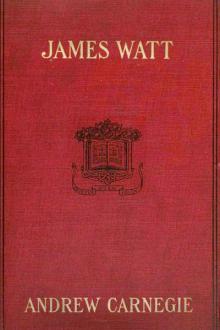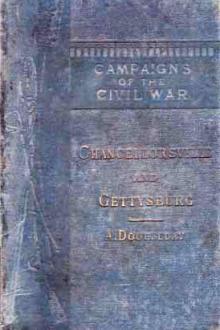James Watt, Andrew Carnegie [fiction book recommendations txt] 📗

- Author: Andrew Carnegie
- Performer: -
Book online «James Watt, Andrew Carnegie [fiction book recommendations txt] 📗». Author Andrew Carnegie
CHAPTER VII
Second Patent
The number and activity of rivals attracted to the steam engine and its possible improvement, some of whom had begun infringements upon the Watt patents, alarmed Messrs. Watt and Boulton so much that they decided Watt should apply for another patent, covering his important improvements since the first. Accordingly, October 25, 1781, the patent (already referred to on p. 91) was secured, "for certain new methods of producing a continued rotative motion around an axis or centre, and thereby to give motion to the wheels of mills or other machines."
This patent was necessary in consequence of the difficulties experienced in working the steam wheels or rotatory engines described in the first patent of 1769, and by Watt's having been so unfairly anticipated, by Wasborough in the crank motion.
No less than five different methods for rotatory motion are described in the patent, the fifth commonly known as the "sun and planet wheels," of which Watt writes to Boulton, January 3, 1782,
I have tried a model of one of my old plans of rotative engines, revived and executed by Mr. Murdoch, which merits being included in the specification as a fifth method; for which purpose I shall send a drawing and description next post. It has the singular property of going twice round for each stroke of the engine, and may be made to go oftener round, if required, without additional machinery.
Then followed an explanation of the sketch which he sent, and two days later he wrote, "I send you the drawings of the fifth method, and thought to have sent you the description complete, but it was late last night before I finished so far, and to-day have a headache, therefore only send you a rough draft of part."
In all of these Watt recommended that a fly-wheel be used to regulate the motion, but in the specification for the patent of the following year, 1782, his double-acting engine produced a more regular motion and rendered a fly-wheel unnecessary, "so that," he says, "in most of our great manufactories these engines now supply the place of water, wind and horse mills, and instead of carrying the work to the power, the prime agent is placed wherever it is most convenient to the manufacturer."
This marks one of the most important stages in the development of the steam engine. It was at last the portable machine it remains to-day, and was placed wherever convenient, complete in itself and with the rotative motion adaptable for all manner of work. The ingenious substitutes Watt had to invent to avoid the obviously perfect crank motion have of course all been discarded, and nothing of these remains except as proofs, where none are needed, that genius has powers in reserve for emergencies; balked in one direction, it hews out another path for itself.
While preparing the specification for this patent of 1781, Watt was busy upon another specification quite as important, which appeared in the following year, 1782. It embraced the following new improvements, the winnowing of numberless ideas and experiments that he had conceived and tested for some years previous:
1. The use of steam on the expansive principle; together with various methods or contrivances (six in number, some of them comprising various modifications), for equalising the expansive power.
2. The double-acting engine; in which steam is admitted to press the piston upward as well as downward; the piston being also aided in its ascent as well as in its descent by a vacuum produced by condensation on the other side.
3. The double-engine; consisting of two engines, primary and secondary, of which the steam-vessels and condensers communicate by pipes and valves, so that they can be worked either independently or in concert; and make their strokes either alternately or both together, as may be required.
4. The employment of a toothed rack and sector, instead of chains, for guiding the piston-rod.
5. A rotative engine, or steam-wheel.
Here we have three of the vital elements required toward the completion of the work: first, steam used expansively; second, the double-acting engine. It will be remembered that Watt's first engines only took in steam at the bottom of the cylinder, as Newcomen's did, but with this difference: Watt used the steam to perform work which Newcomen could not do, the latter only using steam to force the piston itself upward. Now came Watt's great step forward. Having a cylinder closed at the top, while the Newcomen cylinder remained open, it was as easy to admit steam at the top to press the piston down as to admit it at the bottom to press the piston up; also as easy to apply his condenser to the steam above as below, at the moment a vacuum was needed. All this was ingeniously provided for by numerous devices and covered by the patent. Third, he went one step farther to the compound engine, consisting of two engines, primary and secondary, working steam expansively independently or in concert, with strokes alternate or simultaneous. The compound engine was first thought of by Watt about 1767. He laid a large drawing of it on parchment before parliament when soliciting an extension of his first patent. The reason he did not proceed to construct it was "the difficulty he had encountered in teaching others the construction and use of the single engine, and in overcoming prejudices"; the patent of 1782 was only taken out because he found himself "beset with a host of plagiaries and pirates."
One of the earliest of these double-acting engines was erected at the Albion Mills, London, in 1786. Watt writes:
The mention of Albion Mills induces me to say a few words respecting an establishment so unjustly calumniated in its day, and the premature destruction of which, by fire, in 1791, was, not improbably, imputed to design. So far from being, as misrepresented, a monopoly injurious to the public, it was the means of considerably reducing the price of flour while it continued at work.
The "double-acting" engine was followed by the "compound" engine, of which Watt says:
A new compound engine, or method of connecting together the cylinders and condensers of two or more distinct engines, so as to make the steam which has been employed to press on the piston of the first, act expansively upon the piston of the second, etc., and thus derive an additional power to act either alternately or co-jointly with that of the first cylinder.
We have here, in all substantial respects, the modern engine of to-day.
Two fine improvements have been made since Watt's time: first, the piston-rings of Cartwright, which effectively removed one of Watt's most serious difficulties, the escape of steam, even though the best packing he could devise were used—the chief reason he could not use high-pressure steam. In our day, the use of this is rapidly extending, as is that of superheated steam. Packing the piston was an elaborate operation even after Watt's day.
It was not because Watt did not know as well as any of our present experts the advantages of high pressures, that he did not use them, but simply because of the mechanical difficulties then attending their adoption. He was always in advance of mechanical practicalities rather than behind, and as we have seen, had to retrace his steps, in the case of expansion.
The other improvement is the cross-head of Haswell, an American, a decided advance, giving the piston rod a smooth and straight bed to rest upon and freeing it from all disturbance. The drop valve is now displacing the slide valve as a better form of excluding or admitting steam.
Watt of course knew nothing of the thermo-dynamic value of high temperature without high pressure, altho fully conversant with the value of pressures. This had not been even imagined by either philosopher or engineer until discovered by Carnot as late as 1824. Even if he had known about it the mechanical arts in his day were in no condition to permit its use. Even high pressures were impracticable to any great extent. It is only during the past few years that turbines and superheating, having long been practically discarded, show encouraging signs of revival. They give great promise of advancement, the hitherto insuperable difficulties of lubrication and packing having been overcome within the last five years. Superheating especially promises to yield substantial results as compared with the practice with ordinary engines, but the margin of saving in steam over the best quadruple expansion engine cannot be great. Lord Kelvin however expects it to be the final contribution of science to the highest possible economy in the steam engine.
In the January (1905) number of "Stevens Institute Indicator," Professor Denton has an instructive résumé of recent steam engine economics. He tells us that Steam Turbines are now being applied to Piston Engines to operate with the latter's exhaust, to effect the same saving as the sulphur dioxide cylinder; and adds
that the Turbine is a formidable competitor to the Piston Engine is mainly due to the fact that it more completely realizes the expansive principle enunciated in the infancy of steam history as the fundamental factor of economy by its sagacious founder, the immortal Watt.
Watt's favorite employment in Soho works late in 1783 and early in 1784 was to teach his engine, now become as docile as it was powerful, to work a tilt hammer. In 1777 he had written Boulton that
Wilkinson wants an engine to raise a stamp of 15 cwt. thirty or forty times in a minute. I have set Webb to work to try it with the little engine and a stamp-hammer of 60 lbs. weight. Many of these battering rams will be wanted if they answer.
The trial was successful. A new machine to work a 700 lbs. hammer for Wilkinson was made, and April 27, 1783, Watt writes that
it makes from 15 to 50, and even 60, strokes per minute, and works a hammer, raised two feet high, which has struck 300 blows per minute.
The engine was to work two hammers, but was capable of working four of 7 cwt. each. He says, with excusable pride,
I believe it is a thing never done before, to make a hammer of that weight make 300 blows per minute; and, in fact, it is more a matter to brag of than for any other use, as the rate wanted is from 90 to 100 blows, being as quick as the workmen can manage the iron under it.
This most ingenious application of steam power was included in Watt's next patent of April 28, 1784. It embraced many improvements, mostly, however, now of little consequence, the most celebrated being "parallel motion," of which Watt was prouder than any other of his triumphs. He writes to his son, November, 1808, twenty-four years after it was invented (1784):
Though I am not over anxious after fame, yet I am more proud of the parallel motion than of any other mechanical invention I have ever made.
He wrote Boulton, in June, 1784:
I have started a new hare. I have got a glimpse of a method





Comments (0)